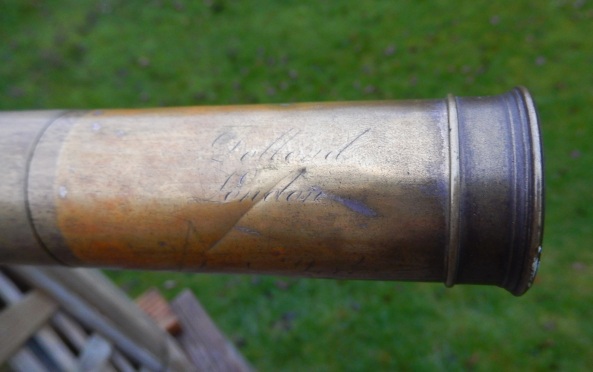Another popular telescope maker already featured on this website is JP Cutts, where two models of his have been described: these were a two draw and a three draw, both with wooden barrels. The two draw was interesting, in that it had an oak barrel, and was signed as JP Cutts & Sons, plus the second line of the engraving saying “Opticians to Her Majesty” (Queen Victoria). This one was sold last year on Ebay, fairly quickly. The three draw unit was obviously earlier, as it had no reference to the appointment to “Her Majesty”, and just mentions “JP Cutts” and no ‘Sons’ – but it quotes the JP Cutts being based in London, which Gloria Clifton dates as after 1836.

This telescope is a single draw with an oak barrel, a design that suggests it is earlier in date maybe, but the format was a popular design for shipboard use. The engraving first line says “JP Cutts & Sons”, which marks it as from a later date, as his sons are quoted to have joined the business in around 1841-45. The second line of the engraving again quotes the “Opticians to Her Majesty” line, so again, it must be dated as after Victoria’s Coronation in June 1838. Possibly only a short time after, as the word ‘Her’ is obviously squeezed into a smaller space than would have been desirable, possibly replacing the word ‘His’. But having seen many other JP Cutts telescopes, I have never seen the engraving using any different (better) spacing.
JP Cutts History
 I recently found a new account of the JP Cutts history. This advises that John Priston Cutts was born in Leeds in February 1787: one of the reasons JP Cutts interests me is that he was Yorkshire based, a fellow Yorkshireman. He was apprenticed as an optical craftsman with the Sheffield company of Proctor and Beilby: this firm also had factory addresses in Birmingham, and operated in both places around 1804 [Two brothers named Beilby were later reported working in Bristol around 1810-1820]. In his later advertising Cutts suggests that he started his business in 1804 (ie aged 17): this was either the start or end of his apprenticeship.
I recently found a new account of the JP Cutts history. This advises that John Priston Cutts was born in Leeds in February 1787: one of the reasons JP Cutts interests me is that he was Yorkshire based, a fellow Yorkshireman. He was apprenticed as an optical craftsman with the Sheffield company of Proctor and Beilby: this firm also had factory addresses in Birmingham, and operated in both places around 1804 [Two brothers named Beilby were later reported working in Bristol around 1810-1820]. In his later advertising Cutts suggests that he started his business in 1804 (ie aged 17): this was either the start or end of his apprenticeship.
The earliest known business address for JP Cutts is in an 1822 Sheffield Directory, at 58 Norfolk Street, Sheffield. Around 1828, he moved the business to Division Street, Sheffield, and it remained there until his death. In addition to optical instruments, Cutts manufactured metal implements such as razors, knives, powder flasks, and liquor flasks.
Cutts opened a branch shop / warehouse in London, probably in about 1836. That year he entered a trademark as a spectacle case manufacturer, with an address of 3 Crane Court, Fleet Street. That venture appears to have been very short-lived, as an 1839 advertisement stated “Late warehouse in London, removed to Sheffield”. He was also said to have had a branch office in New York, briefly.
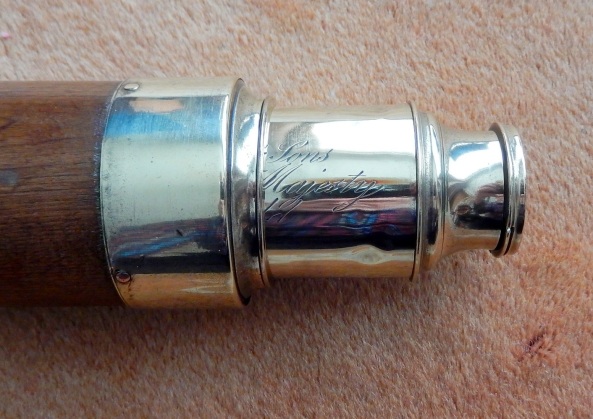
During the 1830s, Cutts became associated with James Chesterman (1792-1867). Chesterman invented a number of devices, including the spring tape measure and a self-winding window blind. An 1837 directory of Sheffield listed “Cutts John Preston, optical, mathl. and philosl. instrument mfr. and sole mfr. of Chesterman’s patent self-acting window blind and map rollers, tape measures, etc. Division St”, and “Chesterman Jas. patentee and mfr. of the newly invented spring tape measures, spring map and window blind rollers, and spring hinges and door closers; at I.P. Cutts’, Division st.” The formal partnership of Cutts, Chesterman and Co. was in existence by 1855, when they exhibited “measuring tapes”, at that year’s Paris Exposition. Another partner, James Bedington (ca. 1811-1890), later joined to form Cutts, Chesterman, and Bedington. That company dissolved in 1859, after Cutts’ death. Chesterman took over the former business, and remained in Sheffield for many decades: Bedington moved to Birmingham.
This account does not refer to another partnership mentioned in Gloria Clifton’s reference book, that of JP Cutts, Sutton and Son, which was active around 1851, in Sheffield and in Hatton Garden, London: they introduced the Trade Mark ‘TRY MF’. It would be good to know what this meant as at first I thought this read ‘Try me’ – indeed the Royal Museums at Greenwich have a unit showing the Trade Mark anchor and they suggest this reads ‘TRY ME’ underneath, but I’m not convinced, it looks like TRY MF to me: their reference is NAV1486 – any suggestions welcomed! I need to polish up the Cutts & Sutton 4-draw telescope, my Accession number #272, which bears this marking, to see what that says – as soon as I can find it that is!
Later comment (Oct 2017): Inspection of various other Cutts scopes, plus one branded “Newton, Halifax” today, shows the TM distinctly shows “TRY MF” as the wording under the Anchor symbol. So the Royal Museum has got that wrong! But it’s always possible the engraving tool or person had it wrong, and perpetuated the mistake – see the previous comments made below…….
Royal Museums at Greenwich have responded to my query, and they reckon the ‘F’ is a fault in the engraving process on the metalwork. In addition they have found an entry placed by the company in the 1870 publication ‘The Handbook to the Manufacturers and Exporters of Great Britain’ that showed the trade mark printed, where it definitely says “TRY ME”, in between two horizontal lines, under the anchor symbol used as part of the Trademark. This was in an article that provided a comprehensive review of the whole history of this company, including their microscopes.
This telescope

Closed up the telescope is 20” long: fully extended it is 36”. The OD is 2.5”, the clear visible diameter of the objective is 1.5”. The wooden main barrel appears to be of oak, and is in good condition. The overall condition is excellent: the brass is beautiful, and the eyepiece is complete with a protective slide over the lens, which sticks out of the bell shaped eyepiece housing when the scope is in use. The only potentially missing item would be an objective lens cap/cover, although the (steel) screws at the objective end holding the lens assembly in place have been replaced with brass screws. At the other end of the barrel the brass collar is held on with what look like copper pins.

The single draw is split in the middle to allow access to the second cartridge containing the two lenses closest to the objective. The end of the single draw is used to create an orifice that is typically used restrict the light passing down the edges of the barrel from the objective lens. The eyepiece cartridge has the other two lenses. All the screw threads unscrew and run easily.
The engraving on the first draw reads:
JP Cutts & Sons
Opticians to Her Majesty
Sheffield
….where the word ‘Her’ is in a slightly smaller font size.
The telescope weight is significant – it probably needs to be supported on the rigging, as it weighs approximately 1.1kg (2.4 lbs or 39 ounces). Presumably on sailing ships the lookouts who climbed the masts did not have to carry telescopes as big as these!
How well does it work?
The telescope focuses easily, and can even be used with spectacles in place! Easily means there is plenty of movement of the draw in and out to move through the point of best focus. The magnification is around 10x, not a high magnification compared to some, but a good wide field of view, for a telescope, makes up for that.
Background data
The scope was bought from A.Miller, a stallholder at the London Scientific Instruments Fair, in October 1999. He seemed to specialise in renovating telescopes that potentially could display beautifully polished wooden barrels, but this one was awaiting treatment, ie not yet renovated. It is Accession number #56.


 Closed up the telescope is 26.5” long, and extended the length is 38”. The single draw, which is made from 1.75” OD brass tubing, has a joint very close to the mounting flange on the end of the barrel section. Inside this break, the lens cartridge is very long, compared to others, and has a mounting shoulder separated from the mounting thread by over 3” – so is very stably and accurately aligned.
Closed up the telescope is 26.5” long, and extended the length is 38”. The single draw, which is made from 1.75” OD brass tubing, has a joint very close to the mounting flange on the end of the barrel section. Inside this break, the lens cartridge is very long, compared to others, and has a mounting shoulder separated from the mounting thread by over 3” – so is very stably and accurately aligned. Trouble is, there are some bits that are missing. Most obvious is the eyepiece cover, probably a bell shaped cover, that screwed onto the outside of the single draw, on the thread there. The function was to position the eye of the user about an inch from the lens at the eyepiece end. The lack of this cover is not a problem if you prefer to wear your spectacles when looking thru the scope, it actually helps a lot. But the eye still needs to be positioned on the centre line of the scope tubes.
Trouble is, there are some bits that are missing. Most obvious is the eyepiece cover, probably a bell shaped cover, that screwed onto the outside of the single draw, on the thread there. The function was to position the eye of the user about an inch from the lens at the eyepiece end. The lack of this cover is not a problem if you prefer to wear your spectacles when looking thru the scope, it actually helps a lot. But the eye still needs to be positioned on the centre line of the scope tubes. Second, presumably there was an objective lens cap, used to protect that lens, but that cap is missing. The shoulder where it would have fitted is clearly identifiable.
Second, presumably there was an objective lens cap, used to protect that lens, but that cap is missing. The shoulder where it would have fitted is clearly identifiable.
 I recently found a new account of the JP Cutts history. This advises that John Priston Cutts was born in Leeds in February 1787: one of the reasons JP Cutts interests me is that he was Yorkshire based, a fellow Yorkshireman. He was apprenticed as an optical craftsman with the Sheffield company of Proctor and Beilby: this firm also had factory addresses in Birmingham, and operated in both places around 1804 [Two brothers named Beilby were later reported working in Bristol around 1810-1820]. In his later advertising Cutts suggests that he started his business in 1804 (ie aged 17): this was either the start or end of his apprenticeship.
I recently found a new account of the JP Cutts history. This advises that John Priston Cutts was born in Leeds in February 1787: one of the reasons JP Cutts interests me is that he was Yorkshire based, a fellow Yorkshireman. He was apprenticed as an optical craftsman with the Sheffield company of Proctor and Beilby: this firm also had factory addresses in Birmingham, and operated in both places around 1804 [Two brothers named Beilby were later reported working in Bristol around 1810-1820]. In his later advertising Cutts suggests that he started his business in 1804 (ie aged 17): this was either the start or end of his apprenticeship.





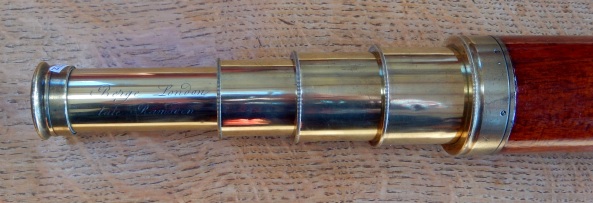

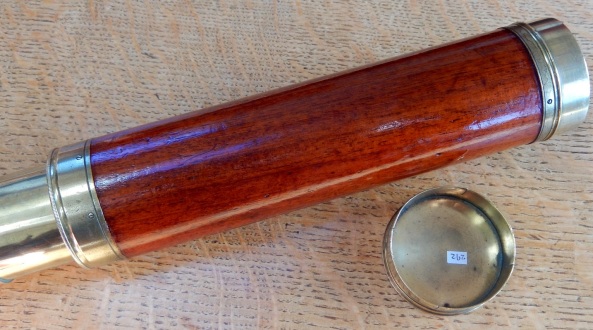

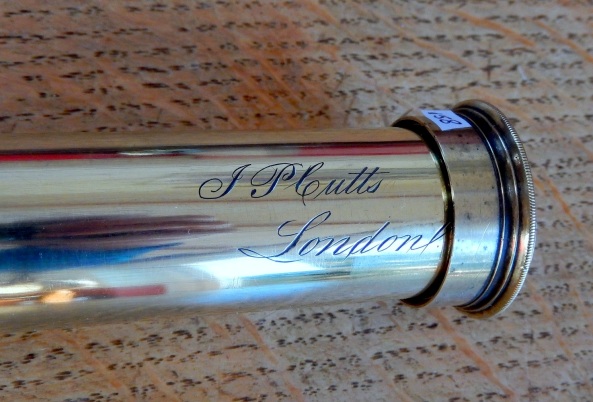
 The OD of the main barrel is almost 1.9”, with the visible lens OD of the objective 1.6”. This assembly has been subjected to a ‘major trauma’, ie a big bang on the side, which has distorted the mounting ring and cracked the side of one of the lenses. This crack does not have any visible effect on the view through the scope.
The OD of the main barrel is almost 1.9”, with the visible lens OD of the objective 1.6”. This assembly has been subjected to a ‘major trauma’, ie a big bang on the side, which has distorted the mounting ring and cracked the side of one of the lenses. This crack does not have any visible effect on the view through the scope.
 A well-known name in London telescope making at the end of the C18 was the partnership of Spencer, Browning & Rust, based in Wapping, near the Pool of London. They started working together from 1784, but the original founders had all died by 1819, and their respective successors continued in business, effectively separately. Spencer, Browning & Rust operated from 66 High Street, (Hermitage Bridge) in Wapping.
A well-known name in London telescope making at the end of the C18 was the partnership of Spencer, Browning & Rust, based in Wapping, near the Pool of London. They started working together from 1784, but the original founders had all died by 1819, and their respective successors continued in business, effectively separately. Spencer, Browning & Rust operated from 66 High Street, (Hermitage Bridge) in Wapping.










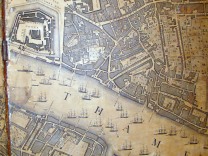 The Hermitage is seen below on an 1805 map of London on show at Chawton House Library in Hampshire. On the North bank of the Thames, Hermitage Dock is shown in the centre, and The Hermitage is on the west side of the dock. The Tower of london is just off this map top left, at the end of St Catherine’s, as can be seen on the smaller picture of the map.
The Hermitage is seen below on an 1805 map of London on show at Chawton House Library in Hampshire. On the North bank of the Thames, Hermitage Dock is shown in the centre, and The Hermitage is on the west side of the dock. The Tower of london is just off this map top left, at the end of St Catherine’s, as can be seen on the smaller picture of the map.




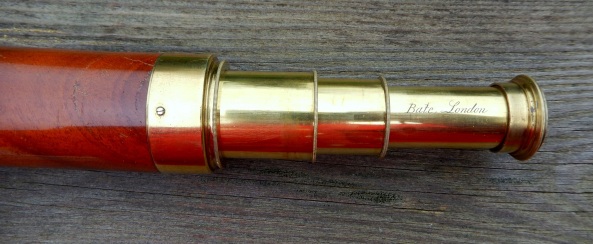
 Robert Brettell Bate was at 21 Poultry from 1824 to 1847 – he died in 1847. He had associations with WC Cox and Geo Stebbing, both notable marine instrument makers from the provinces (Plymouth and Portsmouth). He also transferred one of his apprentices to William Gilbert (2) (see the previous story. His sons John and Bartholomew Bate were also working in the business.
Robert Brettell Bate was at 21 Poultry from 1824 to 1847 – he died in 1847. He had associations with WC Cox and Geo Stebbing, both notable marine instrument makers from the provinces (Plymouth and Portsmouth). He also transferred one of his apprentices to William Gilbert (2) (see the previous story. His sons John and Bartholomew Bate were also working in the business.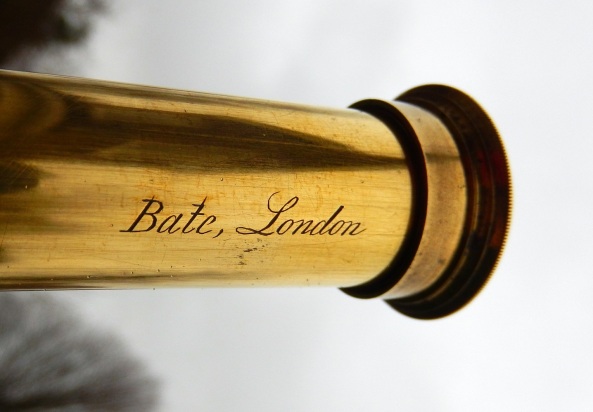


 The whole telescope says “Quality”, starting with the silver plating and decoration around the eyepiece and objective lens. Pick it up and it feels right, but the big surprise is looking through it – the magnification is about twice what you might have been expecting. The lenses in the internal cartridges look good, and must be very carefully sized. One of the draws, the third, obviously what not quite snug enough, so the slider is padded with very thin felt. The sliders themselves have the threads about an inch down in the draw, with a shoulder at the top end, to make a two point mounting for each joint, keeping them tight in line.
The whole telescope says “Quality”, starting with the silver plating and decoration around the eyepiece and objective lens. Pick it up and it feels right, but the big surprise is looking through it – the magnification is about twice what you might have been expecting. The lenses in the internal cartridges look good, and must be very carefully sized. One of the draws, the third, obviously what not quite snug enough, so the slider is padded with very thin felt. The sliders themselves have the threads about an inch down in the draw, with a shoulder at the top end, to make a two point mounting for each joint, keeping them tight in line.
 Sizing is the sort of standard for this style of three draw scope, 29.5” fully open and 9.5” closed, OD is 2”. The mahogany barrel is still polished well, so that has not needed any rework: there is one longitudinal crack. The only quirk in the design would seem to be the extra ring which acts as a 5mm spacer near the objective – this might just be a spacer to enable a focus to be made even on very close objects (20 feet), where the extension required is close to the fully expanded length of the scope.
Sizing is the sort of standard for this style of three draw scope, 29.5” fully open and 9.5” closed, OD is 2”. The mahogany barrel is still polished well, so that has not needed any rework: there is one longitudinal crack. The only quirk in the design would seem to be the extra ring which acts as a 5mm spacer near the objective – this might just be a spacer to enable a focus to be made even on very close objects (20 feet), where the extension required is close to the fully expanded length of the scope.

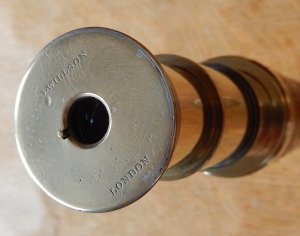 I left this telescope languishing in a box for ten years (after buying it in 2005 on Ebay), not quite understanding why it would not work. In addition it had a problem with one of the mounting rings, the top “flange” edge had come away from the cylindrical slider. Obviously I had not spent enough time looking at it, as I hadn’t noticed the name stamped on the flat face of the eyepiece, under the grime, which turned out to be “Willson G, London”.
I left this telescope languishing in a box for ten years (after buying it in 2005 on Ebay), not quite understanding why it would not work. In addition it had a problem with one of the mounting rings, the top “flange” edge had come away from the cylindrical slider. Obviously I had not spent enough time looking at it, as I hadn’t noticed the name stamped on the flat face of the eyepiece, under the grime, which turned out to be “Willson G, London”.




